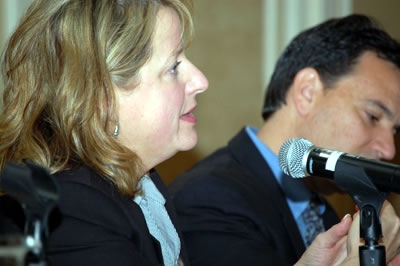How Minnesota saves lives by spreading safety money thinly: Oregon Transportation Summit focus

(First published by BikePortland.org)
Sue Groth’s job: use math and millions of dollars to stop injuries before they happen.
The team Groth leads at the Minnesota Department of Transportation has probably saved a few hundred lives over the last 10 years. In that time they’ve reinvented “highway safety” spending and seen traffic fatalities fall almost twice as fast as they have in Oregon and the rest of the country.
Groth is the plenary speaker at the Sept. 15 Oregon Transportation Summit hosted by OTREC at Portland State University. Michael Andersen of BikePortland spoke to her last week to talk about MnDOT’s daring decision to give up some of the “gobs of money” it gets for highway safety and hand it to local agencies instead.
What’s the nature of your work on the safety movement called Vision Zero, also known as Toward Zero Deaths?
My state happened to be one of the first to adopt it. We have had a program for over 10 years now and have had some pretty good success. We don’t have to accept the fact that 400 people a year die on the roads in Minnesota, or 33,000 nationally.
400?
Oh, I’d better give you a precise number: 387. Minnesota’s had great success. One year we actually got down to 368.
(Editor’s note: 387, it turns out, is seven deaths per 100,000 Minnesotans, down 38 percent since 2002. The national rate is 11 per 100,000; Oregon’s rate is nine per 100,000. Both of those rates are down a little over 20 percent since 2002.)
Wow. Is it just that Swedish people are good drivers?
(laughs) No, it’s more than that. We’ve got good people but we’ve also got good laws and have really made this a priority. When we started this program and started to look at where these were happening, we realized that a lot of the crashes were happening on our local system.
The majority of our fatal and serious crashes happen in rural areas. But in rural areas you don’t have a particular type of intersection or curve that is deadly. These types of crashes tend to happen somewhat randomly. You might not have a “dead man’s curve.” But you could take this money and spread it over a lot of little intersections: lower-cost strategies like pavement markings and lights and signing.
In the past, MnDOT would have just spent that money ourselves, because we have gobs of money to spend on safety. Now we would say, ‘No, we’re going to give that to the local level.’
Who is doing all the calculations you mention? State staff?
We used federal safety dollars and consulting staff to work with the county engineers. We wanted to make sure that the counties could embrace it. And it’s not just the infrastructure. Ninety-three percent of crashes include human error, something that a driver does wrong. You’ve got to address not only the roadway, but the human too.
My impression had been that in Sweden, where Vision Zero was developed, they assume people will always do dumb things, so they focus entirely on the roadway and don’t bother trying to educate users.
I think in the United States we still have a lot we can do with the human side. Thirty percent of our fatal crashes involve drunk driving. (Editor’s note: In Sweden the ratio is between 15 and 20 percent.)
The main knock I’ve heard against Vision Zero comes from street-safety advocates who think it’s just the latest buzzword, that we’re going to clap ourselves on the back and keep doing the same thing.
That’s interesting. To me, it is so not a buzzword. Because we are doing so much differently than we did 10 years ago that it’s incredible.
Why is safety such a powerful argument in the transportation world?
You can look at the sheer numbers of people and the economic cost. But that is nothing compared to anybody who’s ever lost somebody in a traffic death. It’s so personal and it’s so widespread. You never really get over it. That I think is very compelling for lawmakers and public policy people.
When we wanted to start installing cable barrier along our highways there was big pushback from certain parts of our orgnaization, because it was a new thing that they weren’t already doing: When it got hit, we would have to go out and fix it. But today, some of our workers say “This is the best thing we’ve ever done. We used to be the people who used to sit out here and close the road for six hours while they did a reconstruction of a fatal crash. We no longer are responding to those calls, because we have eliminated our fatal crashes.”
We did a study – and this was a pretty good study – we figured we’d saved 80 lives since we started installing this. 80 lives! That’s a lot of people who are going home at night. We don’t even know what life would have been like without those 80 people. I think that’s pretty compelling.
Registration for next month’s Oregon Transportation Summit is now open. Groth’s address, which will be joined by Leah Treat of Portland and Troy Costales of the Oregon Department of Transportation, will begin the event.
